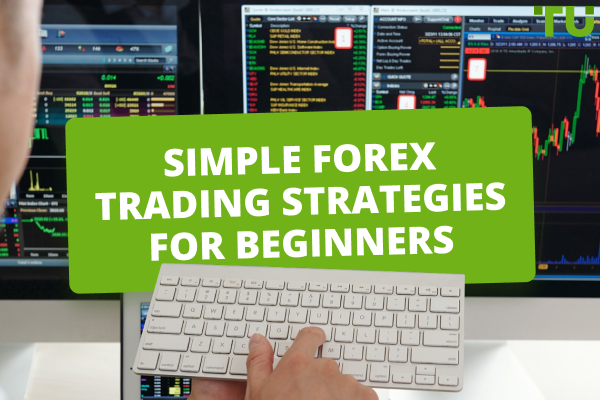Trading Plan Guide in 7 Steps
If you fail to plan, you plan to fail. If you are serious about being a successful trader, you must have a winning strategy for your trading. An accomplished trader will tell you that you have two options: a trading strategy that works or a gamble that fails.
Curating a trading strategy that works requires time, effort, and research. While there are no 100% guarantees, creating a detailed trading plan will hugely increase your chances for profitable trading in the long run.
This article will teach you about a trading plan and the critical steps to creating one. You'll also discover what works and how to avoid the costly mistakes many beginner traders make while trading in the financial markets.
Start trading Forex right now with RoboForex!What is a Trading Plan?
A trading plan is a framework that helps traders navigate the trading process. It establishes the standards within which a trader enters transactions, determines markets, exits trades, and manages risks. The trading plan provides discipline and helps traders stay on track with their strategies and avoid blowing their accounts.
How Does a Trading Plan Help?
A trading plan will help you make rational trading decisions and define your ideal trade criteria. Many beginner traders often get into trouble because they don't have a plan to stick to. A well-designed trading plan will help you avoid heat-of-the-moment decisions.
A trading plan has the following advantages:
-
Objective decisions: you already know when to take profits and cut losses so that you can remove emotions from the equation.
-
Better trading discipline: By following your plan rigorously, you might figure out why specific trades succeed and others do not.
-
Enhance trading skills: Establishing your record-keeping procedure allows you to learn from previous trades.
Are Trading Plans Universal?
No two trading strategies are the same. Each plan contains different distinguishing elements such as preferences, capital, trading goals, and risk appetite. But every trading plan promotes one objective: increasing trading success rates.
Creating a Trading Plan Step-By-Step
Creating a trading plan is one of the most critical steps to becoming an accomplished trader. Until one is created, it’s unwise to begin exploring financial markets, as you would be exposing your trading capital to undue risks. You can develop a trading plan in many ways, in line with your goals and personality. We have curated seven easy steps for creating a typical trading plan.
If you need a more specific framework then do not hesitate to check free trading plan templates prepared by TU experts - Trading Plan Templates For Different Trading Styles
Step 1: Set Specific Trading Goals
The first and most important step in creating your trading plan is to set your financial goals. Be very specific here - define exact dollar amounts you want to achieve. If your account is $20,000, don't just say "I want to grow my account." Instead say "I want to achieve returns of 20% this year which equals $4,000." Also set a monthly goal like "$500 profit per month."
Having measurable goals like this are critical for keeping you motivated and focused. The market will shake you around on a daily basis, but focusing on hitting your monthly and yearly targets will help you stick to your plan and not let emotions hijack you.
In addition to return goals, also set a maximum drawdown level you will tolerate such as 10%. This means if your account drops 10% below the initial level, you will stop trading and reassess. You must protect your capital to survive long-term.
Some traders also set goals around the number of trades, profit factor, percentage of winning trades, etc. We recommend keeping it simple at first with just return targets and drawdown limits. You can add more later.
The most important thing is to set actionable goals you can track. Print out your trading goals and post them where you trade. Seeing the numbers every day will keep you disciplined, motivated, and on track to succeed. Don't launch your trading ship without a defined destination!
Step 2: Define Your Trading Style and Timeframe
Once you know your financial goals, the next step is deciding what general trading approach you will take - day trading, swing trading, or position trading. This will determine what markets you trade and what timeframe charts you use.
Day trading involves holding positions for a few hours or less. Day traders open and close multiple trades within a single session, trying to profit from intraday swings and volatility. This requires closely watching the charts all day and very active trading. It also allows for more frequent profit opportunities.
Swing trading typically holds positions from a few days to a couple weeks. Swing traders look for larger price movements than day traders, and do not need to be glued to their screens. Daily chart monitoring is still required, along with afterhours risk management. This style fits those with a day job or busy schedule.
Position trading involves holding trades for weeks to months to capture larger moves and trends. Checking the charts sporadically is sufficient. This style suits patient traders with a longer outlook.
New traders are recommended to start with swing trading. It provides a happy medium between the intensity of day trading and the long periods of position trading. You can always evolve your style over time.
Step 3: Choose A Market to Trade
Once you've determined your trading timeframe, the next key decision is choosing which financial market to trade - stocks, Forex, futures, or options. As a beginner, it's best to pick just one or two correlated markets to focus on.
Jumping around between many different markets early on is a recipe for failure. Each market has its own unique attributes and risks which takes time to learn. Focusing on just a single market allows you to gain expertise much faster.
If you chose day trading, suitable markets would be major forex pairs like EUR/USD and USD/JPY, or liquid futures like the E-mini S&P 500. For swing trading, you could choose a sector of stocks such as technology or energy. And for position trading, index ETFs, options, or currency pairs would be appropriate.
No matter what market you pick, choose a small subset of instruments to watch closely rather than jumping around. This allows you to study price action patterns and catalysts specific to those names. Master one market at a time - that's the path to lasting success rather than chasing every opportunity.
Step 4: Select Your Trading Strategy
You now know what market you'll trade and your timeframe for trades. The next piece is deciding on your specific trading strategy.
There are endless strategy options to consider - breakouts, reversals, chart patterns, indicators, news events, and more. Do some research and find an approach that resonates with you and fits your rules.
Beginning traders might start with a simple price action strategy. For example, buy when the price breaks above a consolidation after strong volume comes in. Place stop below the most recent swing low. Sell when price breaks downward from a peak.
The benefit of price action is you can see exactly how the market is behaving rather than relying on secondary indicators. Price action combined with volume shows true buying and selling activity.
Whatever strategy you pick, thoroughly backtest it to validate performance. Your trades should demonstrate a clear edge with positive expectancy over hundreds of examples. Tweak the rules until you see consistency.
Beware of over-optimizing - don't curve fit the strategy to historical data. Monitor it in real time to identify weaknesses. No strategy works forever; you'll need to evolve.
Having a defined trading strategy with positive expectancy puts the odds of success in your favor. You'll confidently know when to enter, where to set stops, and when to take profits. A high probability strategy executed consistently is the key.
Step 5: Create Detailed Trading Rules and Plan Each Trade
After you have defined the market, timeframe, and rules, the next step is shaping your specific trading rules and parameters. Detailed trading rules are essential for maintaining consistency and discipline.
Start by setting your entry rules. Will you buy after a break of resistance on high volume, for example? Define your specific triggers and stick to them.
Next determine your profit taking strategy. Many traders work backwards and set a 2:1 or 3:1 reward/risk ratio as a baseline target. If your stop loss is $1, aim for $2 or $3 profit. You can trail stops to allow bigger gains on winners.
Speaking of stops, each trade must have a stop loss defined before entry. This will limit losses on bad trades. Start with no more than 2% of account value at risk per trade. Adjust this with position sizing.
Other trading rules include total holding periods, number of trades per day, account drawdown limits, and so on. Create rules for your situation.
The power of detailed trading rules is they take emotions out of the equation and create consistency. Write them down and keep them visible. Resist any urge to break them - that's the path to ruin.
Sticking to your rules will not guarantee winning every trade. But over the long-run, having an edge and discipline leads to profits. Let the numbers and rules dictate your actions, not fear or greed.
Step 6: Build a Risk Management Plan
The next crucial element is your risk management plan. Don't even think about trading until you have this nailed down.
The first rule is determining your maximum risk per trade - this should be no more than 1-2% of your total account value. For a $20,000 account, maximum risk per trade is $200 - $400.
Use position sizing to limit risk to these levels. Trade smaller share size if the volatility is higher. The idea is no single trade should meaningfully hurt your account value if it loses.
Additionally, limit your total open risk to no more than 5-10% of account value at any time. If you have 5 open trades with 2% risk, that's 10% exposure. Any more than this and drawdowns become too extreme.
Make it a rule to close all trades before weekends to limit exposure to gaps and news announcements. Have stop orders in place in case you can't watch the market.
Lastly, move your stop loss to lock in gains as a trade becomes profitable. Don't get greedy and let winners turn into losers. Protect your capital at all times.
With effective risk rules in place, you can weather storms and survive the long haul. Never risk so much that you cannot trade your way back after declines. You want to still be in the game long after most have failed.
Step 7: Create Your Daily Routine for Preparing and Executing Trades
The foundation of your trading plan is set. The final step is establishing a routine for preparing for the day and executing trades according to your plan, whether you trade stocks, Forex, or both.
If trading stocks, begin each morning by reading news that may impact your watchlist - earnings, analyst ratings, economic data, etc. Know the day's corporate events.
For Forex, start by checking economic news, central bank policies, and developments that may move currency values. Be aware of upcoming reports.
Conduct technical analysis on your markets during active trading hours. For stocks, this is regular market hours. For Forex, preferable time is when London and New York sessions overlap.
Monitor trades after entry. Follow your rules for managing open positions. Stay detached and don't override stops. Stick to the trading plan.
Close Forex trades well before Friday's session ends to limit weekend risk. For stocks, exit before the regular session closes. Analyze the day's trading afterwards.
Having a solid routine aligns with professional trading. You'll plan and execute trades consistently in any market without stress or distraction. That's the path to success.
Where Can I Trade
The top trading platforms for beginners should provide three advantages. First, the platform should be easy to use and suitable for beginners. Second, it should provide educational materials and high-quality stock market research. Finally, the top platforms should be registered with top-tier regulators to ensure asset security. Below are two brokers that satisfy these requirements.
Interactive Brokers (Best for stock trading)
Interactive Brokers provides low-cost, direct access trading services to both professionals and beginners. The broker allows you to trade stocks, options, mutual funds, ETFs, cryptocurrencies, futures, bonds, and currencies in more than 150 markets.
Traders can enjoy low commissions and low margin rates on over 8300 funds. Interactive Brokers should pique your interest if you are a fresh trader looking to make regular stock trades on US-listed exchanges and overseas marketplaces. Beginner traders prefer to use the IBKR LIte plan on iOS and Android devices, as it’s easier to use.
👍 Pros
•Wide range of offerings around the world and across asset classes
•Low margin interest rates
•Excellent trading tools
•Strong research and tools
👎 Cons
• Desktop version can be difficult to navigate.
Coinbase (Best for crypto trading)
Cryptocurrency trading has grown in popularity, owing to its increasing value and appeal. While buying and trading crypto can be scary at first, one of today's finest crypto apps, Coinbase, makes it easier.
Coinbase, founded in 2012, is one of the largest and safest platforms. The platform boasts an easy-to-use interface that makes one-time or recurring crypto investments a snap. If you’re looking to break into Crypto, Coinbase is for you. Coinbase has two trading platforms, Coinbase and Coinbase Pro, and a crypto-wallet service. Anyone with basic trading skills will find it convenient to use Coinbase.
👍 Pros
•Beginner-friendly interface and easy purchase process.
•Strong user reviews and security ratings.
👎 Cons
•High fees for convenience.
Summary
A good trading plan will help you avoid basing trading decisions on emotions or the fear of missing out on profitable trading opportunities. With it, you can monitor your performance, anticipate outcomes, refine strategies, and enhance your trading performance.
The secret to successful trading entails being confident and re-evaluating each trade. With time, you'll have honed your talents to the point where you don't have to second-guess your trading choices. Also, keep in mind that implementing a trading plan doesn't mean you will never lose a trade. After all, even seasoned traders have bad days too. A trading plan will ensure more wins in the long run.
FAQs
Do professional traders use a trading plan?
Professional traders develop trading plans that they implement rigorously. This is one of the qualities that distinguish them as experts. Professional trading plans will have precise money management requirements and definite entry and exit procedures.
Does using a Forex trading plan template guarantee any success?
Nothing guarantees trading success, but a well-thought-out trading strategy can help you avoid failure and put you on the road to a more prosperous trading career. In addition, a trading plan removes some barriers to success, making it easier to place profitable trades and hone your trading skills over time.
Can I change my trading plan?
As you gain experience and learn more about the markets and yourself as a trader, you will undoubtedly want to alter your trading strategy. It should adapt and evolve in response to shifting market conditions and your trading talents and preferences.
What makes a good trader?
Successful traders develop discipline, patience, adaptability, mental toughness, independence, and forward-thinking.
Team that worked on the article
Ivan is a financial expert and analyst specializing in Forex, crypto, and stock trading. He prefers conservative trading strategies with low and medium risks, as well as medium-term and long-term investments. He has been working with financial markets for 8 years. Ivan prepares text materials for novice traders. He specializes in reviews and assessment of brokers, analyzing their reliability, trading conditions, and features.
Dr. BJ Johnson is a PhD in English Language and an editor with over 15 years of experience. He earned his degree in English Language in the U.S and the UK. In 2020, Dr. Johnson joined the Traders Union team. Since then, he has created over 100 exclusive articles and edited over 300 articles of other authors.
The topics he covers include trading signals, cryptocurrencies, Forex brokers, stock brokers, expert advisors, binary options. He has also worked on the ratings of brokers and many other materials.
Dr. BJ Johnson’s motto: It always seems impossible until it’s done. You can do it.
Mirjan Hipolito is a journalist and news editor at Traders Union. She is an expert crypto writer with five years of experience in the financial markets. Her specialties are daily market news, price predictions, and Initial Coin Offerings (ICO). Mirjan is a cryptocurrency and stock trader. This deep understanding of the finance sector allows her to create informative and engaging content that helps readers easily navigate the complexities of the crypto world.











